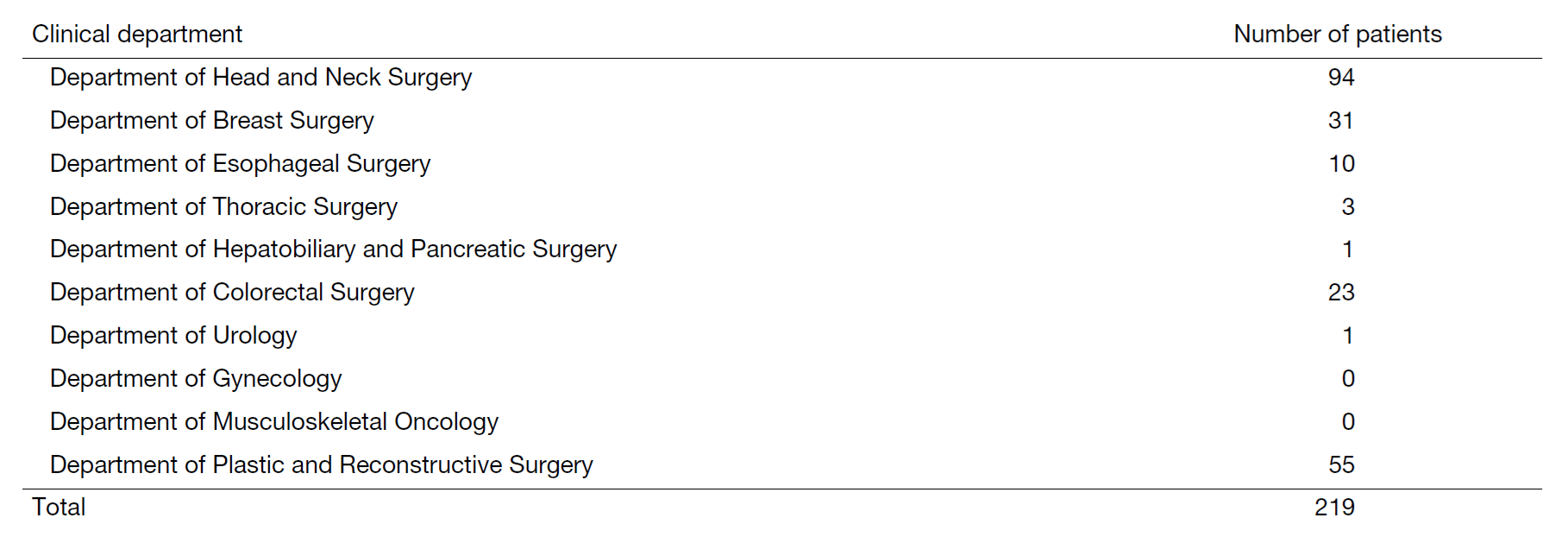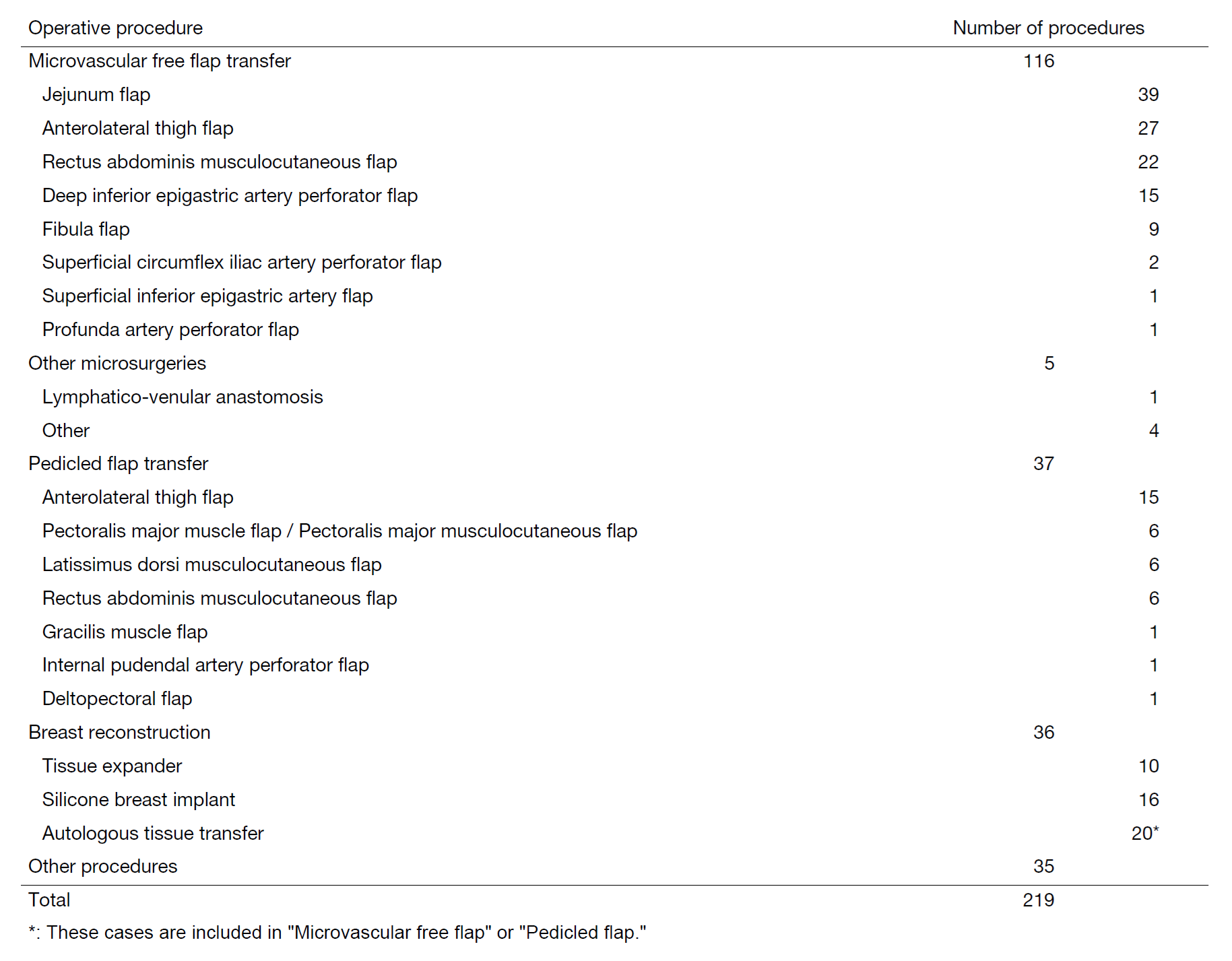Annual Report 2023
Department of Plastic and Reconstructive Surgery
Takuya Higashino, Azusa Oshima, Kiichi Furuse, Kohei Hashimoto, Takeaki Hidaka, Ryosuke Matsusaka
Introduction
The Department of Plastic and Reconstructive Surgery mainly focuses on surgical reconstruction following cancer ablation. Reconstructive procedures using free flap transfer with microvascular anastomosis are the most important operations in our institution. In addition, several methods such as tissue transfer with pedicled flaps, local flaps, and skin grafting are used for reconstructive surgery. The objectives of reconstructive surgery are not only the morphological reconstruction, but also the restoration of postoperative functions after ablative surgery. The quality of life (QOL) of patients can be improved with functional and morphological reconstruction.
The Team and What We Do
Three plastic surgeons cover reconstructive operations in the National Cancer Center Hospital (NCCH) East in Kashiwa. The reconstructive surgeries are performed in cooperation with surgeons from other departments within the hospital, such as the Departments of Head and Neck Surgery, Breast Surgery, Esophageal Surgery, Thoracic Surgery, and Colorectal Surgery (Table 1).
In the NCCH East, head and neck reconstruction is the most frequently performed operation accounting for approximately 50% of the reconstructive surgeries. Free jejunal transfer, anterolateral thigh flap transfer, and rectus abdominis musculocutaneous flap transfer are the frequently used procedures in the head and neck region (Table 2). A weekly conference is held with doctors of the Departments of Head and Neck Surgery, Radiation Oncology, and Head and Neck Medical Oncology. Breast reconstruction using autologous tissue transfer was employed in 2003. Since then, patients’ needs for breast reconstruction have increased. Furthermore, lymphatico-venular anastomosis as a surgical treatment for lymphedema of the extremities was introduced in 2013.
Table 1. Number of patients (April 2023 to March 2024) 

Table 2. Operative procedures (April 2023 to March 2024)

Research Activities
Plastic and reconstructive surgery has focused on the following four aspects in the surgical treatment of cancer to contribute to improving patients’ QOL: 1) obtaining good functional recovery, 2) reducing postoperative complications, 3) achieving less donor site morbidity, and 4) treating postoperative complications after cancer ablation. Establishing a standard for reconstructive surgery and developing new techniques of reconstructive surgery are the most important aims of our studies to address these four aspects. In 2017, we started to take an active role in a new multi-institutional analysis of risk factors for functional outcomes after tongue reconstruction. Additionally, as the principal investigator of the research, we also started the multicenter observational study for evaluating the impact of radiotherapy-related late skin and soft tissue injuries in the neck on QOL of patients with head and neck cancer in 2022.
Education
We accept a large number of young plastic surgeons from all over Japan as residents and train them to become reconstructive surgeons. We also train them to become future opinion leaders in the field of reconstructive surgery.
Future Prospects
The promotion of multi-institutional studies on reconstructive surgery will provide our patients with high-precision and evidence-based medical services.
List of papers published in 2023
1. Oshima A, Wakabayashi M, Ikeno T, Matsuura K, Hayashi R, Higashino T. Second free jejunum transfer after flap loss does not affect oral intake: A retrospective case-control study. Journal of plastic, reconstructive & aesthetic surgery, 88:208-223, 2024
2. Hidaka T, Miyamoto S, Furuse K, Oshima A, Matsuura K, Higashino T. Machine learning approach to predict tracheal necrosis after total pharyngolaryngectomy. Head & neck, 46:408-416, 2024
3. Kondo A, Umezawa H, Fukunaga Y, Oshima A, Higashino T, Ogawa R. Supermicrovascular anastomosis training using chicken wings and colored water . Journal of plastic, reconstructive & aesthetic surgery, 84:531-536 , 2023
4. Araki J, Mori K, Yasunaga Y, Onitsuka T, Yurikusa T, Sakuraba M, Higashino T, Hashikawa K, Ishida K, Sarukawa S, Hamahata A, Kimata Y, Matsumoto H, Terao Y, Yokogawa H, Sekido M, Asato H, Miyamoto S, Hyodo I, Nakagawa M. A Novel Risk Model for Predicting Dysphagia after Tongue Reconstruction: A Retrospective Multicenter Study in Japan . Plastic and reconstructive surgery, 152:693e-706e , 2023
5. Higashino T, Oshima A, Fukunaga Y. Combination of an Exteriorized Monitoring Flap and Hand-held Doppler for Simple and Reliable Monitoring of a Free Jejunal Graft Transfer in Hypopharyngeal Reconstruction Microsurgery . Journal of Plastic and Reconstructive Surgery, 2:118-121 , 2023
